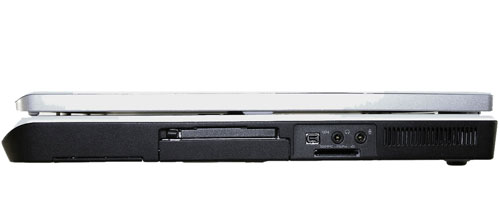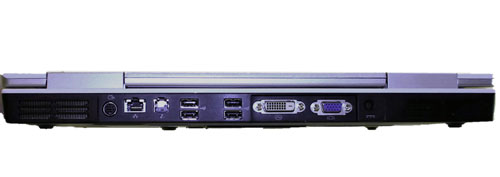Dell DTR Laptop Shootout - M1710 vs. E1705
by Jarred Walton on May 30, 2006 1:30 PM EST- Posted in
- Laptops
Features
We've already stated that the M1710 and the E1705 are very similar, and the primary difference comes at the lower end of the spectrum. Here's a quick rundown of the available features for both systems.| System Configuration Options | ||
| Dell XPS M1710 | Dell Inspiron E1705 | |
| Processor | Intel Core Duo T2400/T2500/T2600 (1.83/2.00/2.16 GHz) | Intel Core Duo T2300/T2400/T2600 (1.66/1.83/2.16 GHz) Intel Core Solo T1300 (1.66GHz) |
| Chipset | Intel 945PM 64-bit Dual-Channel | Intel 945PM or Intel 945GM 64-bit Dual-Channel |
| FSB Speeds | Up to 667 MHz | Up to 667 MHz |
| Memory Speeds | DDR2-533, DDR2-667 | DDR2-533, DDR2-667 |
| Memory Slots | (2) x SO-DIMM, max. 4GB, DDR2, Dual Channel supported | (2) x SO-DIMM, max. 4GB, DDR2, Dual Channel supported |
| Graphics | NVIDIA GeForce Go 7900 GS 256MB or 7900 GTX 512MB GDDR3 |
Intel 950GM 128MB Shared (512MB System Memory) or 224MB Shared (1GB+ System Memory) (Optional) ATI Mobility X1400 256MB (Optional) NVIDIA GeForce Go 7800 256MB (Optional) NVIDIA GeForce Go 7900 GS 256MB |
| Display | 17" WUXGA (1920x1200) UltraSharp with TrueLife | 17" Wide Screen WXGA+ (1440x900) or (Optional) 17" Ultrasharp Wide Screen WUXGA (1920x1200) with TrueLife |
| Expansion Slots | One ExpressCard 54mm slot supporting 1.5V and 3.3V, ExpressCard/34 and ExpressCard/54, 26 pins | One ExpressCard 54mm slot supporting 1.5V and 3.3V, ExpressCard/34 and ExpressCard/54, 26 pins |
| Hard Drive | 60/80/100 7200 RPM | 60/80/100/120GB 5400 RPM or 60/80/100GB 7200 RPM |
| Optical Drive | DVD+/-RW with Dual-Layer DVD+R Write Support | 24X CD Burner/8xDVD Combo Drive or 8x DVD+/-RW with Dual-Layer DVD+R Write Support |
| Networking/ Communications |
Integrated 10/100/1000 PCIe Gigabit Ethernet and V.92 56K Modem (Optional) Dell Wireless 1390 802.11g Mini Card (Optional) Dell Wireless 1490 802.11a/g Mini Card (Optional) Intel Pro/Wireless 3945 802.11a/b/g Mini Card (Optional) Dell Wireless 350 Bluetooth Internal (2.0 + Enhanced Data Rate) |
Integrated 10/100 Ethernet and V.92 56K Modem (Optional) Dell Wireless 1390 802.11g Mini Card (Optional) Dell Wireless 1490 802.11a/g Mini Card (Optional) Intel Pro/Wireless 3945 802.11a/b/g Mini Card (Optional) Dell Wireless 350 Bluetooth Internal (2.0 + Enhanced Data Rate) |
| Audio | 24-bit High Definition Audio with 2.1 Speakers | Integrated Sigmatel HD 24-bit Audio or (Optional) Sound Blaster Audigy ADVANCED HD 24-Bit Audio |
| Left I/O Ports | 2 x USB 2.0 | 2 x USB 2.0 |
| Right I/O Ports | 4-pin Unpowered IEEE 1394A, 5-in-1 Flash Reader (MS, MS Pro, SSD/SDIO, MMC, xD, CD Type I/II, IBM MicroDrive), Headphone and Microphone connectors | 4-pin Unpowered IEEE 1394A, 5-in-1 Flash Reader (MS, MS Pro, SSD/SDIO, MMC, xD, CD Type I/II, IBM MicroDrive), Headphone and Microphone connectors |
| Back I/O Ports | 1 x RJ45 LAN 4 x USB 2.0 1 x RJ11 Modem 1 x DVI-D 1 x VGA 1 x S-VIDEO Out |
1 x RJ45 LAN 4 x USB 2.0 1 x RJ11 Modem 1 x DVI-D 1 x VGA 1 x S-VIDEO Out |
| Keyboard | 87 Key QWERTY (US) | 87 Key QWERTY (US) |
| Battery | 9-Cell 80WHr "Smart" Lithium Ion | 6-Cell 53WHr "Smart" Lithium Ion or 9-Cell 80WHr "Smart" Lithium Ion |
| Dimensions | 1.7"x15.5"x11.3" (HxWxD) 8.8 lbs. (Display, 9-Cell battery, DVD-Combo drive) |
1.7"x15.5"x11.3" (HxWxD) 7.61+ lbs. (Display, 9-Cell battery, DVD-Combo drive increase weight) |
| Power Adapter | 130W 1.42"x2.56"x6.67" (HxWxD), 1.68 lbs. with cables | Ac Adapter - 90W 1.35"x2.39"x6.04" (HxWxD), 1.19 lbs. with cables |
| Chassis | Metallic Black Dell XPS M1710 or Special Edition Formula Red Dell XPS M1710 |
Dell Inspiron E1705 |
| Other Features | XPS 16 Color Configurable Accent Lighting Trackpad with scroll bars |
Trackpad with scroll bars |
The first difference comes in terms of supported processors. The M1710 can naturally support the same processors, but Dell doesn't offer anything lower than the Core Duo T2400 (1.83 GHz) processor in the XPS systems. The E1705 in contrast can be purchased with the Core Duo T2300 (1.66 GHz), or you can even opt for the Core Solo T1300. The price difference between the Core Solo and Core Duo isn't enough that we would actually recommend going that route, however.
 |
| Click to enlarge |
The next major difference comes with the default LCDs. The XPS systems come with a WUXGA UltraSharp LCD (1920x1200), while the Inspiron E1705 defaults to WXGA+ (1440x900). You can get the same display with the E1705, but it's a $150 upgrade. Some people might actually prefer the WXGA+ display anyway, as 1920x1200 resolution on a 17 inch LCD can result in small text on many applications. We would like the option of getting a WSXGA+ (1680x1050) as well.
 |
| Click to enlarge |
The memory and storage offerings follow a similar pattern. The XPS only comes with 7200RPM hard drives, ranging from 60GB to 100GB. The E1705 includes those three hard drives, but it also adds four 5400RPM drives to the list of available choices, ranging from 60GB to 120GB. On the memory front, XPS laptops come with a minimum of 1GB of RAM, and all of the memory offerings are DDR2-667 (other than the insanely expensive 2x2GB configurations: $1800 for DDR2-533, or $3000 for DDR2-667 - not that we would actually recommend either upgrade at those prices). The Inspiron E1705 adds a low-end 512MB option, DDR2-533 as a choice at every memory configuration, and drops the 4GB upgrades. The low-end Core Solo E1705 gives you the choice of either a DVD burner or a CD-RW/DVD-ROM combo drive, while all of the other models come with a DVD burner by default.
 |
| Click to enlarge |
Video card choices on the XPS are limited to the 7900 GS or the 7900 GTX. The E1705 also offers the 7900 GS now ($349 upgrade), but you can also choose to go with integrated GMA950 graphics, ATI Mobility Radeon X1400 HyperMemory ($149 upgrade), or GeForce Go 7800 ($199 upgrade). Of the various graphics card offerings, we have to say that there's little point in getting the X1400 HyperMemory given the cost, at least if you're interested in playing games. If you need more graphics power than the integrated graphics provide, the extra $50 to get the GeForce Go 7800 will more than double graphics performance.
The 7900 GS is the fastest of the graphics options for the Inspiron models, and with the 90 nm manufacturing process it may actually produce less heat than the GeForce Go 7800. It's difficult to recommend spending almost twice as much money, but it should come with a decent increase in performance. The GeForce Go 7800 only has 16 pixel pipelines, whereas the GeForce Go 7900 GS comes with 20 as well as higher clock speeds. If you're really interested in high-powered graphics performance, you can of course upgrade to the XPS and get the GeForce Go 7900 GTX instead. We'll have more to say later on the graphics card choices, and while the X1400 isn't great for games, it does have other benefits.
The remaining differences are generally minor. Of course there's the aforementioned difference in appearance. The XPS comes with an 80 WHr (9 cell) battery by default, and the Inspiron comes with a 53 WHr (6 cell) and offers the 80 WHr battery as an upgrade. Somewhat interesting is that the external power brick is a 130W model for the XPS and only 90W for the Inspiron. The 7900 GTX configuration is likely the reason for the different power brick, as otherwise the two laptops are basically the same. The XPS power brick does weigh a bit more as well, but given the total system weight it's unlikely that you would notice the extra couple of ounces.
That takes care of the general overview, but before we get to the benchmarks we want to look at some of the specific shared components. We'll also take a look at how the laptops are put together.










34 Comments
View All Comments
Gary Key - Tuesday, May 30, 2006 - link
Jarred will be reviewing these in the near future.tthiel - Tuesday, May 30, 2006 - link
I've been issued plenty of Dell laptops at the various companies I have worked for and they were all cheap plasticky junk. I've lost track of how many died on me. I was just given a new Thinkpad T43P and it is much better. Very well made, rock solid. So many of the engineers where I work wanted those instead of Dells that they had to restructure the ordering process and images to take care of all the new Thinkpads.JarredWalton - Tuesday, May 30, 2006 - link
I've heard about problems with ThinkPads now that Lenovo has taken over. (I haven't used any personally, so I can't say for sure.) I have also used many of the older Inspiron models, and have been unimpressed. These are definitely in a different league, however -- the cheap plastic case (at least on top) has been replaced by aluminum, for example. The problem is that most businesses don't buy higher end Dell laptops; they go with the more value oriented offerings, and whenever prices cut you can be sure that quality is cut as well.We're hoping to expand our mobile coverage in the future, so this is merely the beginning. As time goes on, we'll have more products that we can directly compare new offerings with. For now, I'm generally impressed with what the E1705 offers. Impressed enough that I recommended one to a family member, after browsing around looking for a suitable equivalent. Getting a large laptop with a 17 inch (or larger) display, 1920x1200 resolution, dual core processor, etc. is pretty difficult right now. Getting one with 2 GB of RAM for $2300 is even more difficult. Not everyone wants a laptop this large, certainly, but for those that do the E1705 is quite good.
jenson - Monday, January 7, 2013 - link
when cheap laptops really got a good shake, with many models looking and behaving a lot more like their costly cousins than in the past.